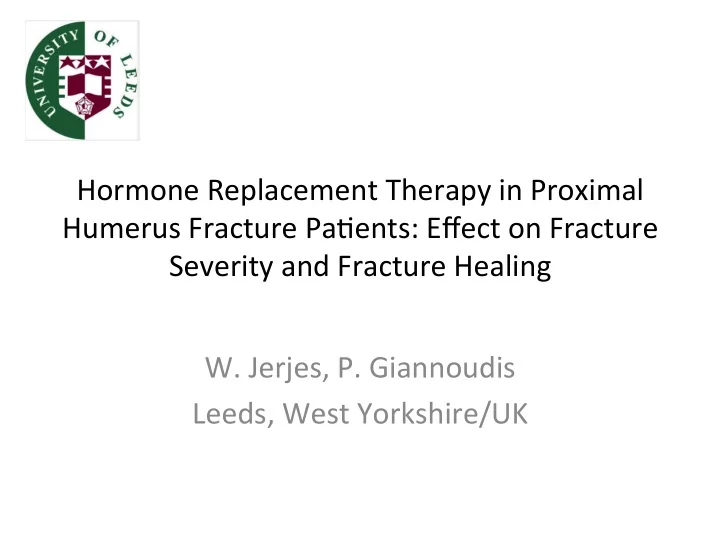

Hormone Replacement Therapy in Proximal Humerus Fracture Pa7ents: Effect on Fracture Severity and Fracture Healing W. Jerjes, P. Giannoudis Leeds, West Yorkshire/UK
Target group • Incidence: rising - osteoporosis - elderly. • Low-energy trauma - mechanical fall - females. • Retrospec7ve compara7ve study - rela7onship: - HRT and fracture - Effect on wound and fracture healing
Study design 2317 pa7ents were treated with closed injuries Leeds Teaching Hospitals NHS Trust, UK The inclusion criteria included: • Females of >45 years of age • Good health status (ASA I or II only) • No balance problems • No mental health issues • Not diabe7c • Not suffering from neuromuscular weakness • Not requiring a walking aid • No history of falls • No previous fractures.
Study groups 822 pa7ents • Never had HRT • Had HRT for <3 years • Had HRT for ≥3 years • Having HRT at 7me of injury
Outcome factors • Primary - Time to fracture union - Time to wound healing • Secondary - Post injury or postopera7ve complica7ons (pain, bleeding, swelling, infec7on, non-union, mal union, delayed union, compartment syndrome and neurovascular impairment) - Sa7sfactory RoM at 4 weeks - Mobility at last R/V (same before injury, worse)
Demographics Cause of injury Mechanical fall 733 Age (at 7me of injury) Assaults 56 Mean 53.2 Minimum-Maximum 46-77 Road traffic collisions 28 Sports injuries 5 Standard devia7on ±4.3 Neer classifica7on ASA One-part 665 ASA I 589 Two-part 78 ASA II 233 Three-part 53 Four-part 26 Classifica7on as per HRT Never had HRT 243 Had HRT for <3 years 257 Interven7on Had HRT for ≥3 years 188 Conserva7ve 712 Having HRT at 7me of injury 134 Opera7ve 110
Rx group Never had Had HRT Had HRT Having P-value (n = 822) HRT for <3 for ≥3 HRT at (n = 243) years years 7me of (n = 257) (n = 188) injury (n = 134) CON SUR CON SUR CON SUR CON SUR CON SUR 712 110 191 52 226 31 177 11 118 16 Neer classifica7on One-part (n=665) 661 4 159 1 215 1 174 0 113 0 .158 Two-part (n=78) 44 34 30 15 9 12 1 1 4 3 .073 Three-part (n=53) 7 46 2 20 2 12 2 7 1 4 .065 Four-part (n=26) 0 26 0 16 0 3 0 3 0 4 <.001 Fracture displacement <1cm or <45 O 661 4 159 3 215 1 174 0 113 0 - >1cm or >45 O 51 106 32 49 11 30 3 11 5 16 -
Rx group Never had Had HRT Had HRT Having P-value (n = 822) HRT for <3 for ≥3 HRT at (n = 243) years years 7me of (n = 257) (n = 188) injury (n = 134) Pain (n=89) 23 66 13 43 7 18 1 3 2 2 .03 Bleeding (n=18) 2 16 2 13 0 3 0 2 0 0 .132 Swelling (n=169) 82 87 46 50 23 22 9 4 12 3 <.001 Infec7on - S (n=12) 5 7 2 5 3 2 0 0 0 0 .142 Infec7on – D (n=19) 3 16 1 13 2 1 0 1 0 1 <.001 Mal union (n=17) 17 0 6 0 4 0 3 0 4 0 .063 Delayed union (n=42) 14 28 8 18 5 9 0 0 1 1 <.001 Non-union (n=19) 17 2 8 1 5 0 2 0 2 1 .061 NV impairment (n=5) 4 1 1 0 1 0 2 0 0 1 - Comp. syndrome (n=0) 0 0 0 0 0 0 0 0 0 0 - LRTI (n=8) 1 7 0 2 0 2 1 1 0 2 - UTI (n=14) 2 12 0 6 2 7 0 1 0 0 .06 DVT (n=0) 0 0 0 0 0 0 0 0 0 0 -
Rx group Never had Had HRT Had HRT Having P-value (n = 822) HRT for <3 for ≥3 HRT at (n = 243) years years 7me of (n = 257) (n = 188) injury (n = 134) RoM (n=763) 697 66 184 26 221 18 177 8 115 14 <0.001 Last R/V Same (n=778) 702 76 185 33 224 24 176 9 117 10 - Worse (n=44) 10 34 6 19 2 7 1 2 1 6 0.002 Wound healing Mean (weeks) 2 3 2 4 2 3 2 3 2 3 0.032 Min-Maxi 1-2 2-5 1-2 2-5 1-2 2-4 1-2 2-3 1-2 2-3 - SD ±1 ±1 ±1 ±1 ±1 ±1 ±1 ±1 ±1 ±1 - Time to union Mean (weeks) 11 13 13 15 10 11 10 11 10 11 <0.001 Min-Max 8-15 9-15 9-15 12-15 8-12 9-12 8-12 9-12 8-12 9-12 - SD ±2 ±2 ±2 ±1 ±2 ±1 ±2 ±1 ±2 ±1 -
To take away • Pa7ents who never used HRT undergoing surgery: - More likely to sustain 4-part fracture - Increase delay in fracture healing - Increase in postopera7ve delayed wound healing - Increase in postopera7ve pain - Increase in deep surgical site infec7ons
Conclusion • Current and past use of HRT for more than 3 years appears to be associated with a reduced severity of fracture at the proximal humerus. • As long as the pa7ent had/having HRT, they are unlikely to suffer from mobility issues, delayed fracture or wound healing.
Thank you Ques7ons?
Recommend
More recommend